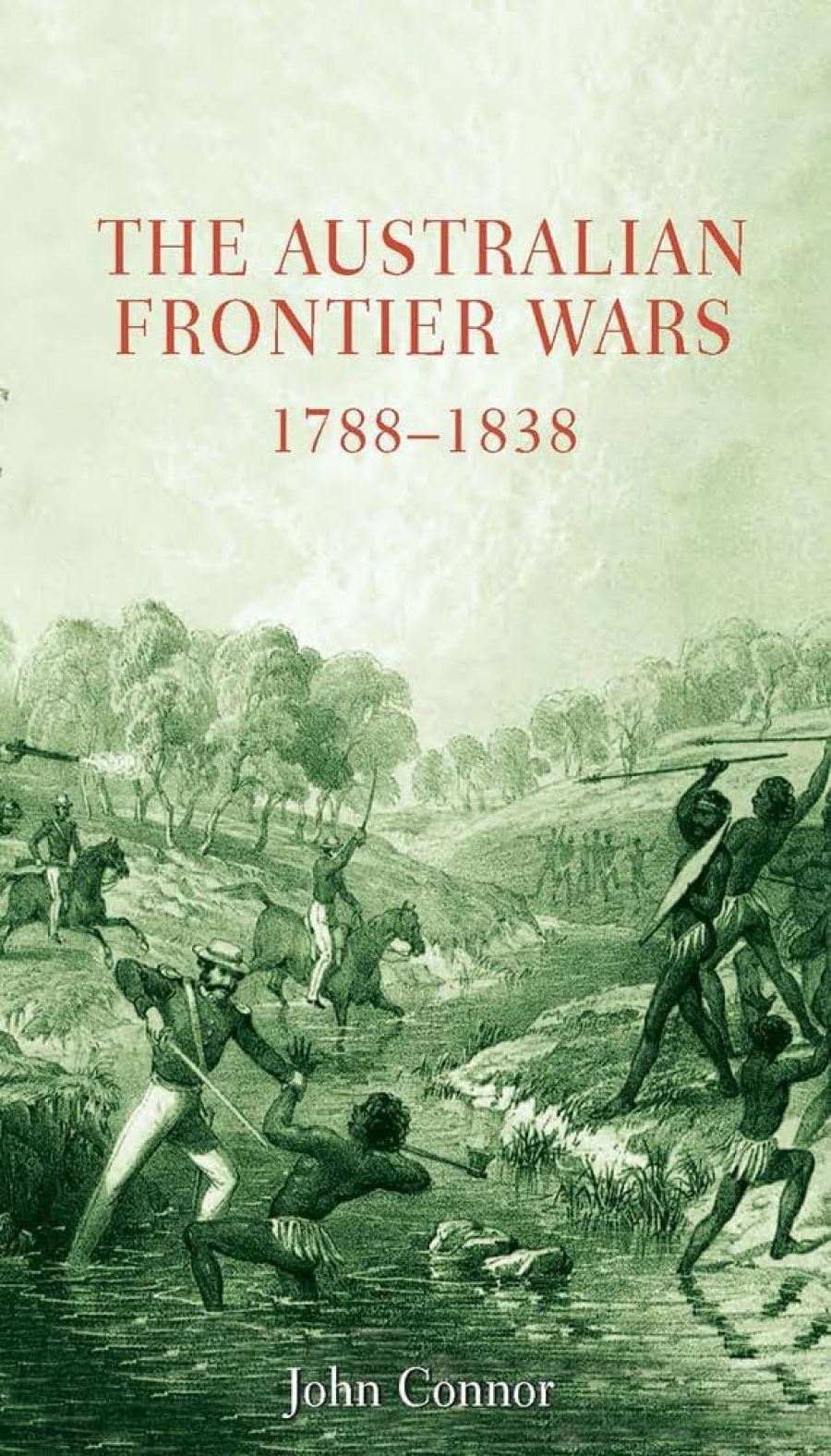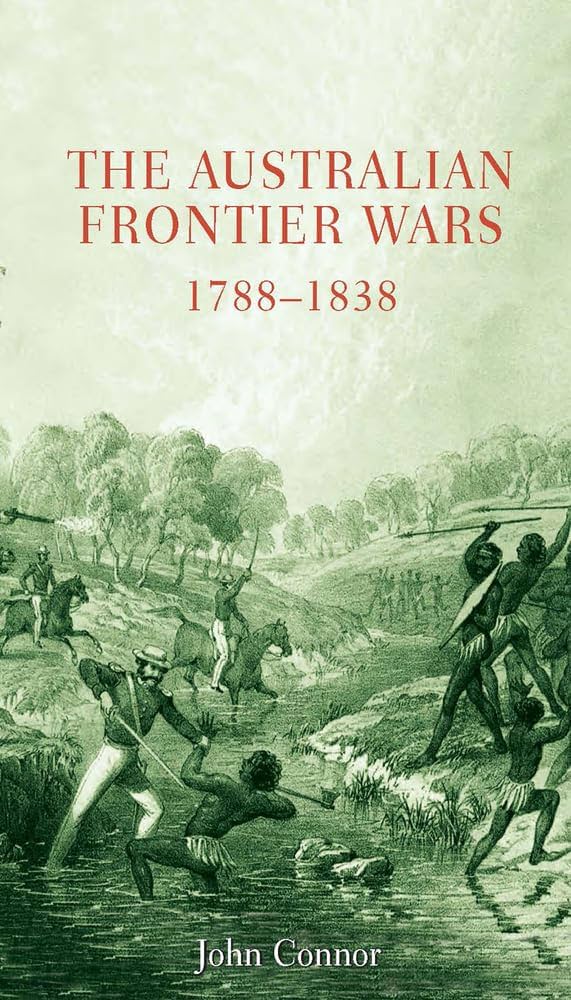
- Free Article: No
- Contents Category: Australian History
- Review Article: Yes
- Article Title: New Perspectives on the Frontier Wars
- Online Only: No
- Custom Highlight Text:
In the aftermath of the ideological jousts between Henry Reynolds and Keith Windschuttle about the level of violence on the colonial frontier, a new book has appeared that tackles the issue from a fresh perspective. The author, John Connor, is a military historian. In this meticulously researched and highly readable book, he uses the methods of military history to examine the weapons, tactics and conduct of warfare on the Australian frontier during the first fifty years of British colonisation. Connor emerges from the fray with exciting new findings.
- Book 1 Title: The Australian Frontier Wars 1788–1838
- Book 1 Biblio: UNSW Press, $29.95 pb, 175 pp, 0 86840 756 9
- Book 1 Cover Small (400 x 600):

- Book 1 Cover (800 x 1200):

First, he points out that the British were invaders of the Australian continent and while they were anxious not to encounter the Aborigines, they had no hesitation in fighting them when the need arose. He admonishes Australian historians for calling the invaders ‘Europeans’ – as if they had no political affiliation to Britain and the empire. In invading Australia, the British used the military resources of their empire against the Aborigines to consolidate their occupation. Yet the Australian frontier was not universally violent: take, for example, Sydney between 1788 and 1791, when the naval and marine officers had a genuine desire to avoid conflict with the Eora. However, at certain times and in certain places, there was sustained conflict that can only be defined as ‘war’.
Connor also finds that the Aborigines were traditionally a fighting people who adapted their skills, weapons and knowledge of their country to great effect against British settlers and soldiers. The British Army arrived with experience of frontier warfare in other parts of the empire, but at first found it difficult to operate on the Australian frontier. The absence of horses for most of the troops further restricted their mobility. Aboriginal tactics overcame British muskets, and Aboriginal warriors evaded British soldiers. Connor notes the success of Pemulwuy and his Aboriginal cohort in harassing and evading British troops in the Nepean–Hawkesbury area in 1795. In these circumstances, a distinctive form of ‘Australian frontier warfare’ developed, whereby Aborigines, settlers and the military each devised new kinds of strategies to survive.
The situation changed in 1825, however, when soldiers were provided with horses. This extra mobility, and the use of Aboriginal guides, enabled them to track and attack Aboriginal groups with impunity. Yet, in Van Diemen’s Land, the colonial government refused to use mounted forces on the grounds of expense. Instead, it deployed 2000 men on the Black Line in 1830, and blew out the colonial budget. Connor notes: ‘A small unit of mounted troops operating in the settled districts could have sufficiently harassed the Tasmanian Aborigines to force them into negotiations and done this more effectively and with less cost than the Line operation.’
The mobility of the Mounted Police is best illustrated by Major Nunn’s expedition to the Liverpool Plains in 1838. His Mounted Police party pursued a large body of Kamilaroi over a great distance, for an extended period of time, leading to their massacre at Waterloo Creek. Nunn believed that terrorising the Gwydir Aborigines would stop them attacking British settlers and livestock. Connor is in no doubt that the massacre enabled settlers to consolidate their hold on the Gwydir and advance north to the Barwon and Macintyre rivers. Ironically, this occupation was short-lived. The drought and the collapse in wool prices forced settlers to abandon their stations in the early 1840s.
Finally, Connor argues that, while some British troops killed Aborigines indiscriminately, the army was generally a moderating force preventing excessive violence. When soldiers left the fighting to settlers and civilian police officers after 1838, the Australian frontier became a more violent place. Connor leaves little room for doubt about the reality of the British occupation of Australia. At no point were the Aborigines treated as British subjects. By encouraging settlers to occupy Aboriginal land and then refusing to view the resultant fighting for that land as ‘war’, the British government created the conditions that led settlers and the military to act secretly and brutally against Aborigines in actions such as the Waterloo Creek and Myall Creek massacres. Connor concludes that the reality of Aborigines on the frontier was that they were sovereign peoples fighting to defend their lands.
This book is the first contribution by a military historian to the debate about the Australian colonial frontier. In this regard, it is a ground-breaking text. It brings a fresh approach to some old questions, and presents a clear-eyed, unsentimental view of the frontier, in the context of British military policy in an expanding empire. It also lays the groundwork for more contributions from this perspective. More importantly, this book is the first to place the Australian frontier wars into the mainstream of military history. Does this mean that it is now possible to consider the Black Line and the Waterloo Creek Massacre alongside Gallipoli, the Kokoda Trail and the Battle of Long Tan as significant military events in Australian history? This would be a mighty shift in our understanding of the frontier.


Comments powered by CComment